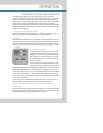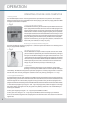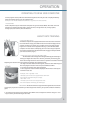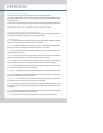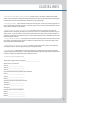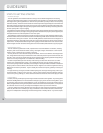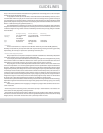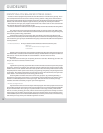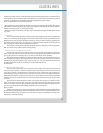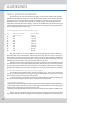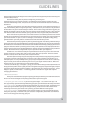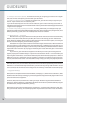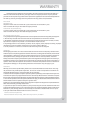
11
GUIDELINES
Keep in mind that the ACSM recommendations are guidelines for the average person, not a champion
athlete training for the Olympic Games.
An appropriate warm-up and cool-down, which would also include flexibility exercises, is also
recommended. While many of you will need to train with more mileage and at a greater intensity to
race competitively, the important factor to remember for most people is that if they follow the ACSM
guidelines of physical activity they will attain increased physical and health benefits at the lowest risk.
Below is a table outlining the guidelines (Table 1.1).
The ACSM guidelines, if followed, can result in permanent lifestyle changes for most individuals.
The good news is that, with the right approach, exercising at home can and should be pleasant. You can
combine strength training, aerobic exercise and flexibility activities that you enjoy and gain valuable
health benefits.
Strength Training Aerobic Exercise Stretching
Frequency 2 to 3 times/week 3 to 5 times/week 3 to 6 times/week
Intensity 8-12 reps 60-80% of max HR
until fatigue
Time 20-40 minutes 20-60 minutes 10 minutes
Type 10 exercises any rhythmical 10 stretches
activity
> Flexibility
To be in total balance it is important to be flexible. While not part of the ACSM guidelines,
flexibility is important for you to perform tasks that require reaching, twisting and turning your body.
Hip flexibility, for example, is important to preventing lower back pain.
> Exercise and Body Composition
Body composition is an important component of health-related fitness. Good body composition
results from aerobic activity, strength training and proper diet.
Your everyday caloric balance will determine whether you will gain or lose weight from day-to-day.
Caloric balance refers to the difference between the calories you take in from food eaten and caloric
expenditure or the amount of energy you put out in daily activities, work or exercise.
Body weight is lost when caloric expenditure exceeds caloric intake or when caloric intake is less
than caloric expenditure. It is a known physiological fact that one pound of fat is equal to 3500 calories
of energy. Though it is predictable that shifts in caloric balance will be accompanied by changes in body
weight, how your body loses weight varies on the various programs you may undertake to lose weight.
For example, low calorie diets cause a substantial loss of water and lean body tissue, such as muscle. In
contrast, an exercise-induced negative caloric balance results in a weight loss of primarily fat stores. If
you were to add a resistant training component to your program, you may also see a slight increase in
weight due to a gain in muscle mass, while an aerobic based program usually results in a maintenance
of muscle mass. While both approaches to weight loss are effective, aerobic activity
is found to be very effective because metabolism stays sustained for longer periods of time and energy.
Expenditure is greater with activities that use large muscle groups such as walking, cycling, cross-county
skiing, etc.
Follow these guidelines when engaging in a weight loss program that combines exercise and
caloric restriction:
> Ensure that you are consuming at least 1,200 calories per day in a balanced diet. You need to con-
sume calories for everyday bodily, healthy functions.
> You should not exceed more than a 500 to 1,000 calories per day negative caloric balance, combining
both caloric restriction and exercise. This will result in a gradual weight loss, without a loss of lean body
weight (muscle). You should not lose more than 2 pounds per week on a diet.



